Lush green plants literally transform the house, bring an atmosphere of comfort and positive energy. Some simply decorate with their decorative properties, others have a beneficial effect on the air, people. There are many varieties, but the best indoor plants for decoration will be presented to you by the top rating from the Expert’s Choice team.
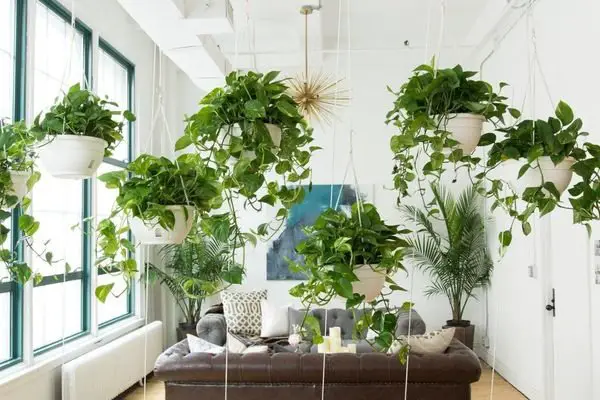
indoor plant selection Criteria
The two most important factors for which we selected the nominees for our review are visual appeal and utility for the premises, residents. With the advice of experts in the field, we have identified several leaders. When placing them according to the top positions, we took into account the following characteristics:
- Plant size;
- Free space area;
- Demanding to the location;
- Watering conditions;
- The need for lighting;
- Feeding rules;
- Decorative properties;
- Benefit, harm to premises, people;
- Breeding and landing rules;
- Growth rate, a lifetime.
The comparative analysis resulted in a top list of 12 positions. These are 5 nominees, distinguished by their decorativeness, as well as 7 flowering plants. Not the last role in the selection was played by the reviews of the owners, which determined the pros and cons of each.
best indoor plants for decoration
The first category of the rating is represented by indoor plants with a beautiful crown. They are distinguished by high aesthetic characteristics, but do not bloom at home or do it very rarely. But they delight others with beauty, original design. The Expert’s Choice presents 6 names of decorative deciduous indoor plants, leaders in the reviews.
Ficus Benjamin
The first review is a mulberry bush with small leaves. Dedicated to Spanish botanist Jackson Benjamin Daydon. For him, only adaptation to a new place of residence is important, which lasts 3 months.
The homeland has not been precisely established due to the high prevalence of the South Asian flora. What is the use of ficus for the home? It purifies the air, ionizes it. Helps reduce stress, tones the body.
Watering rules: because of the great love for a humid climate, watering alone is not enough, you still need to spray the crown. It is especially badly needed during the summer heat, in winter with artificial heating.
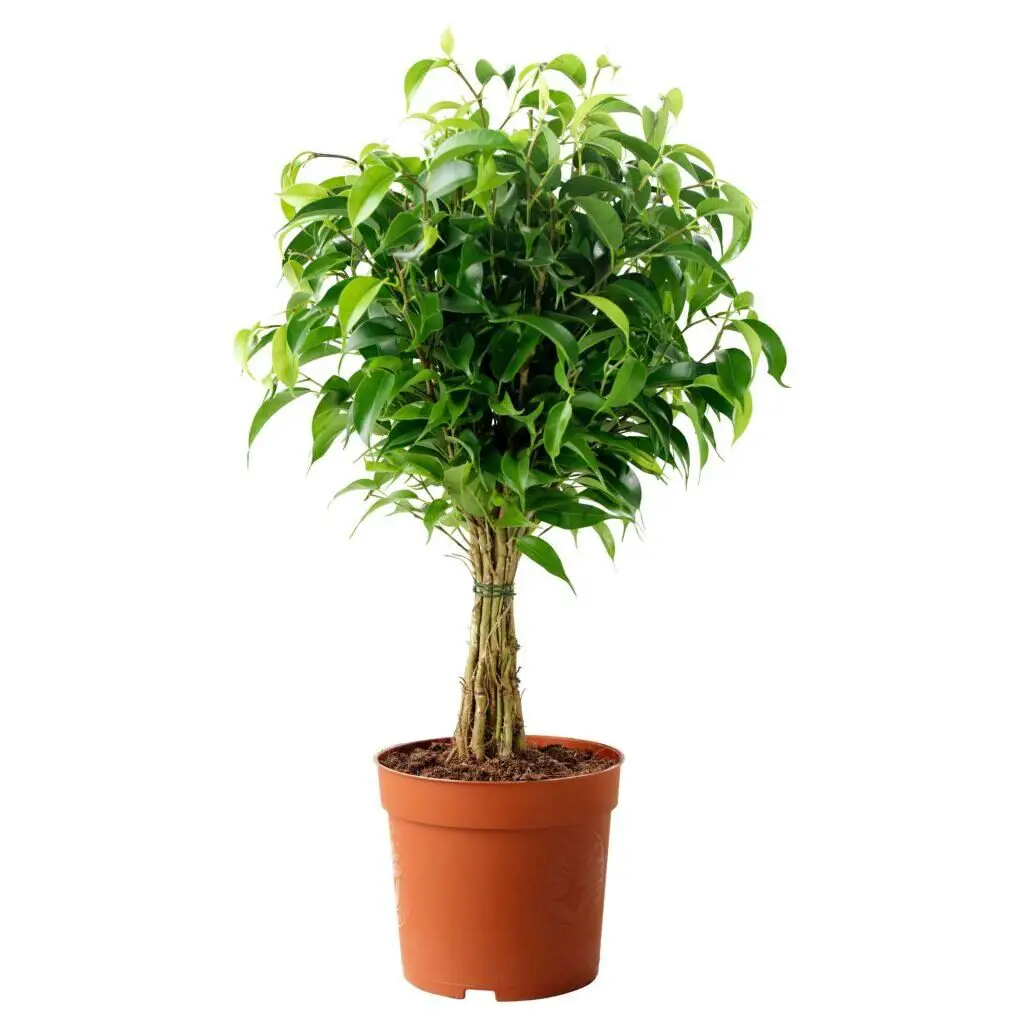
The height depends not only on the care, but also on the variety, usually it is 0.5-3 m. The growth rate is average, about 25 cm per year. This is a perennial plant with an original crown pattern. It does not bloom in indoor conditions. In greenhouses, it can form syconia – spherical inflorescences that resemble berries from a distance.
Advantages:
- Spectacular crown;
- Carries positive energy;
- Ionization and purification of room air;
- Unpretentious cultivation;
- Propagation by cuttings, layering, seeds;
- Keeps decorative all year round.
Disadvantages:
- Requires artificial lighting;
- Frequent spraying.
Ficus Benjamin is an unpretentious, ornamental plant. He deserves to take his place inside the home greenhouse. The optimum air temperature is from 18 to 30 degrees. Greens may fall off from frequent rearrangements.
You may also like Best Feng Shui Indoor Plants.
Dracaena
Dracaena is third in our listing of best indoor plants for decoration. The flower belongs to the family of asparagus, succulents, trees. Moisture-loving and thermophilic. Resembles a tropical palm tree. Designed to cleanse the energy at home, fight depression, attract love and happiness.
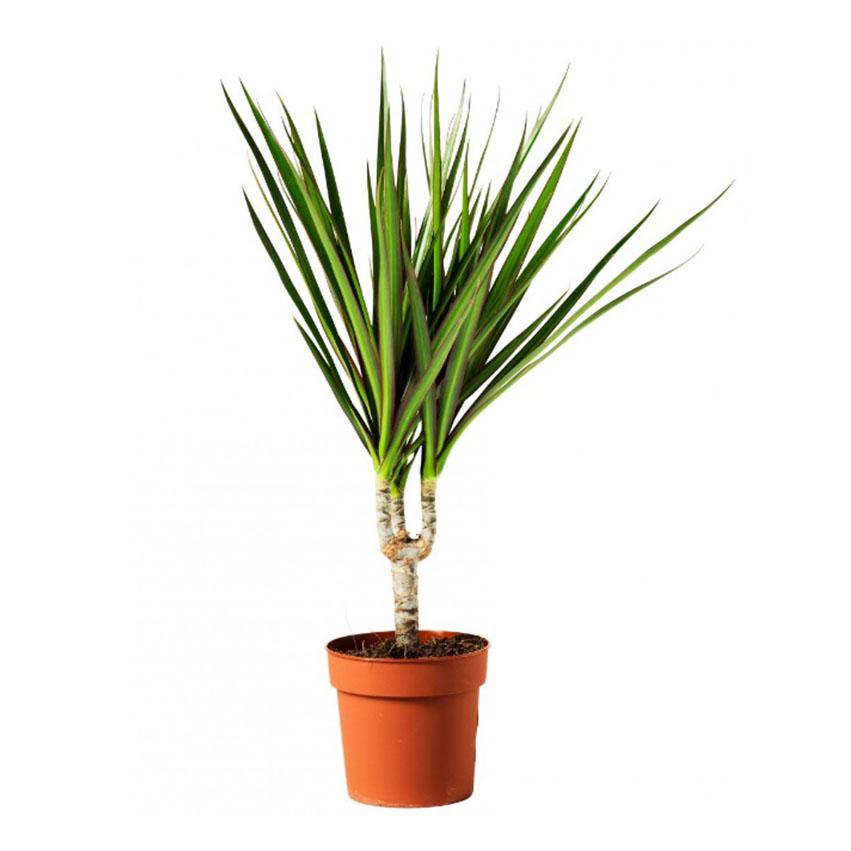
Origin – Canary Islands. Dracaena leaves convert carbon dioxide into oxygen through photosynthesis. Respiratory pores are absorbed by vapors of toluene, formaldehyde, ammonia. On “exhalation” the air is humidified, bactericidal substances are released, destroying pathogens.
The appearance is colored or spotted leaves, crowning the bare and slender trunk in the form of a cap. The height is usually from 30 to 90 cm, it all depends on the variety (more than 100). Propagated vegetatively: by pieces of the stem or tops of the cuttings.
It grows slowly – no more than 15 cm per year. Lighting should be diffused without direct sunlight. A comfortable temperature for the nominee will not be lower than + 18 degrees. With good care, it lives for 5-15 years. Requires feeding, if it is the spring and summer seasons, the growth period.
Advantages:
- Filtration, air purification;
- Unpretentiousness:
- Easy reproduction;
- Highly decorative plant;
- Neutralization of negative energy;
- Harmoniously for the interior.
Disadvantages:
- Frequent watering and spraying;
- Takes up a lot of space.
According to the teachings of Feng Shui, 4 stems of an ornamental culture can bring happiness and good luck. 5 allow you to attract wealth and positive energy, 7 – improve health. 8 stems guarantee the success of any endeavor.
Check it out best detoxifying indoor plants.
Sensevieria
Stemless, perennial and evergreen plant of the asparagus family. The flower was named after the prince of San Severo, Raymond di Sangro. Unpretentious, adapts to adverse conditions.
It grows in Africa, North America, South Asia. Long beautiful leaves are able to purify the air, saturate it with oxygen. Energy absorbs aggression and stimulates mental capacity.
Watering rules: infrequently used settled, soft water collected after precipitation. The contrast of the crown pattern directly depends on the level of lighting. With a lack of it, they fade, if it is too bright, then they turn yellow.
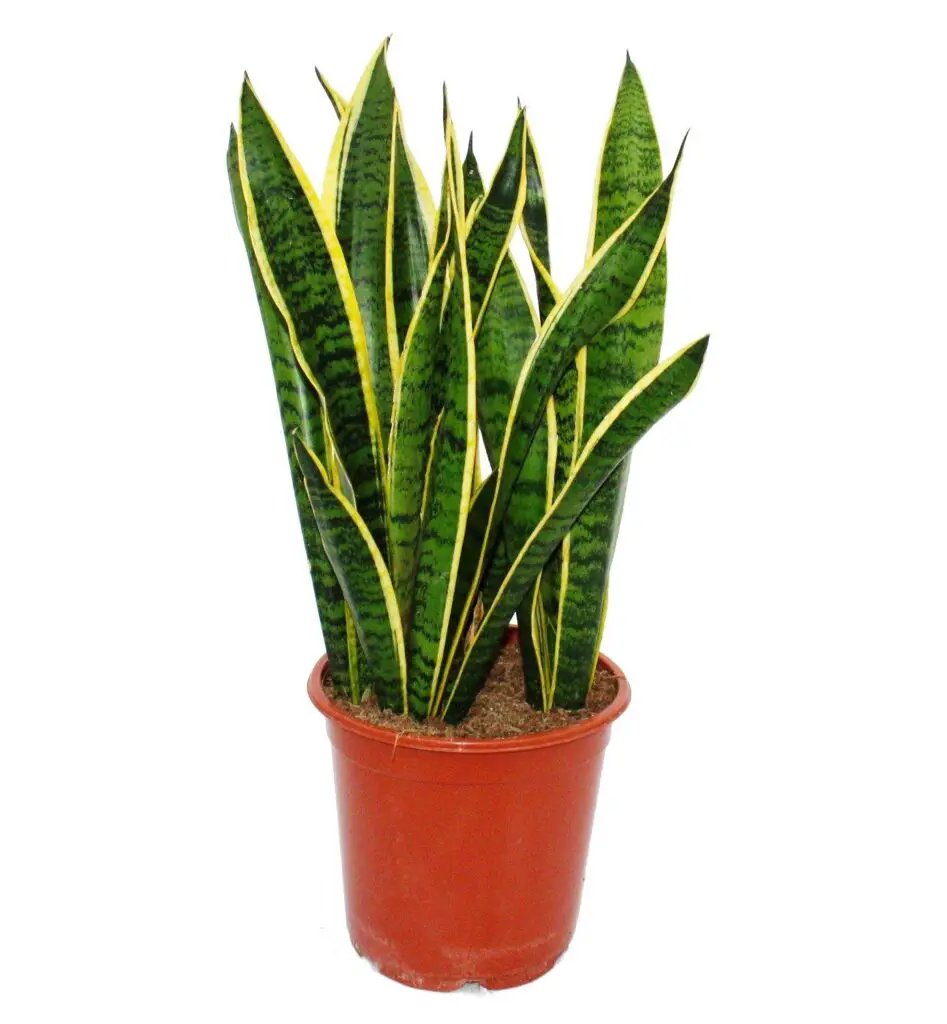
The dense leathery leaves end with a pointed end. In some species, they grow up to 120-150 cm long. Blooms annually for 2 weeks in a row. A peduncle appears from the outlet, small cream-colored flowers are located on it. They are collected in racemose inflorescences, exuding the aroma of vanilla and cloves.
Advantages:
- Spectacular bloom;
- Air purification;
- Absorption of aggressive energy;
- Propagation by seeds, rhizome, cuttings;
- Unpretentiousness;
- Rare watering.
Disadvantages:
- Disease tendency;
- Requires illumination.
If sansevieria blooms at home, it is time to fulfill a long-planned undertaking. During flowering, she blesses for a new business, promises him good luck. Popular among designers for decorating interiors or creating flower arrangements.
Aloe
Succulent plant. Due to its unique composition, it has anti-inflammatory, bactericidal, antibacterial effects. It is successfully used in cosmetology, pharmacology, classical and traditional medicine.
The homeland is the islands of Barbados, Curacao, the south of the Arabian Peninsula. Healing juice is extracted from the leaves of a four-year-old flower; in a tree-like aloe, the stem is processed. The gel is used to treat burns and wounds due to its antibacterial and antifungal properties.
Watering rules: in summer, frequent every day, in winter up to 1-2 times a week. Watering should be done from a container with a long spout so that water does not get into the base of the crown. Regular accumulation of moisture in the outlet will lead to the death of the trunk, death.
Aloe has no stem or is very short. Growth 30-50 cm in height. Lanceolate leaves are thick, fleshy, green or gray-green in color with jagged edges. At the base, some can reach 4-6 cm in width. Reproduction: cuttings, children, seeds.
Advantages:
- Use in medicine, cosmetology, food industry;
- Unpretentiousness;
- A source of antioxidants;
- Antiseptic properties;
- Content of biologically active natural components;
- Rejuvenation.
Disadvantages:
- Do not use extracts for diabetes mellitus, pregnant women, breastfeeding;
- Vulnerable to moisture.
Aloe is a popular medicine for various diseases. To concentrate nutrients before harvesting, it is not watered for 2 weeks, large fleshy leaves are used, breaking off at the base. Useful substances are stored up to 4 hours after collection.
See also best indoor plants for dust allergy.
Monstera
This nominee represents the Aroids. The literal translation of the term “monstrum” is a monster. The fact is that with its huge size monstera can scare away. It is invaluable in converting carbon dioxide to oxygen.
America is considered the homeland (mainly its center, south). The installer is unpretentious in terms of air, light, and the frequency of water supply. Moisturizes, ionizes, but stores poison inside itself (if it gets on the skin, there will be an allergic reaction).
Watering: after the top layer of the earth has dried out, moderately in winter, often in summer. Water can be from precipitation or separated, but always at room temperature. He does not like stagnant moisture, then the soil turns green, roots and shoots rot.
Large dark green leaf plates are leathery to the touch. They differ in rounded slots of various sizes. Blooms in a large cob. Thick branches, like climbing lianas, may have aerial roots.
Advantages:
- Showiness of appearance;
- Humidification, air ionization;
- Protection against electromagnetic radiation;
- Predicts the weather;
- Interior decoration;
- Absorption of carbon dioxide.
Disadvantages:
- Poisonous juice;
- Big sizes.
Monstera eliminates dust, bacteria, and viruses around it. It is able to soothe headaches, calm the nerves, and increase concentration. In Feng Shui, it acts as a talisman, looks original in the living room.
best indoor flowers for decoration
The second category contains indoor plants that bloom often or even regularly. They are compact, so they can be placed anywhere without requiring a lot of free space. To prolong the active phase, the subcortex and proper care are important. 6 nominees became the best according to Houseplantspro.
Violet
A representative of the Gesneriev family, which does not take up much space on the windowsill. It blooms almost all year round. A large number of varieties and species (about 32,000). Suitable for people prone to allergies.
Originally from East Africa (Kenya, Tanzania). If the energy in the house is positive, the violet feels great.
Needs systematic hydration. It is important to water not directly, but through a pallet, by wick or drip. In order for the plant to be healthy, to bloom magnificently, the soil mixture in the pot is changed once a year to a fresh one.

The violet grows as a low bush without a central stem. The foliage is dense, light or dark green. Flowers can be smooth, double, of various colors (combined, patterned).
Advantages:
- Regular, lush bloom;
- Compactness;
- Hypoallergenic;
- Tenderness, grace of inflorescences;
- Energy balance normalization.
Disadvantages:
- Not for standard watering;
- The need for regular fertilization.
If the plant does not bloom, the reasons for this may be high humidity, lack of light, drafts, bay. The pot should be small, because until the roots fill the entire space, there will be no flowering.
Take a look at best large indoor plants for beginners.
Azalea
Plant from the genus of rhododendrons, heather family. It has anti-inflammatory and bactericidal properties, relieves severe fatigue, clarifies thoughts. Gives the beneficial effect of aromatherapy.
Homeland – mountain forests of Europe, Japan and China. Azalea should be present in the homes of creative people. Relieves inflammation, eye fatigue. Heals a hangover. It is customary to give it before unwanted separation.
Watering: in summer and during flowering – every day, very abundantly. After a while, excess moisture must be removed from the pallet. It is sometimes helpful to immerse the pot in a bowl of water for 1 to 2 hours. The air temperature is 12-15 degrees.
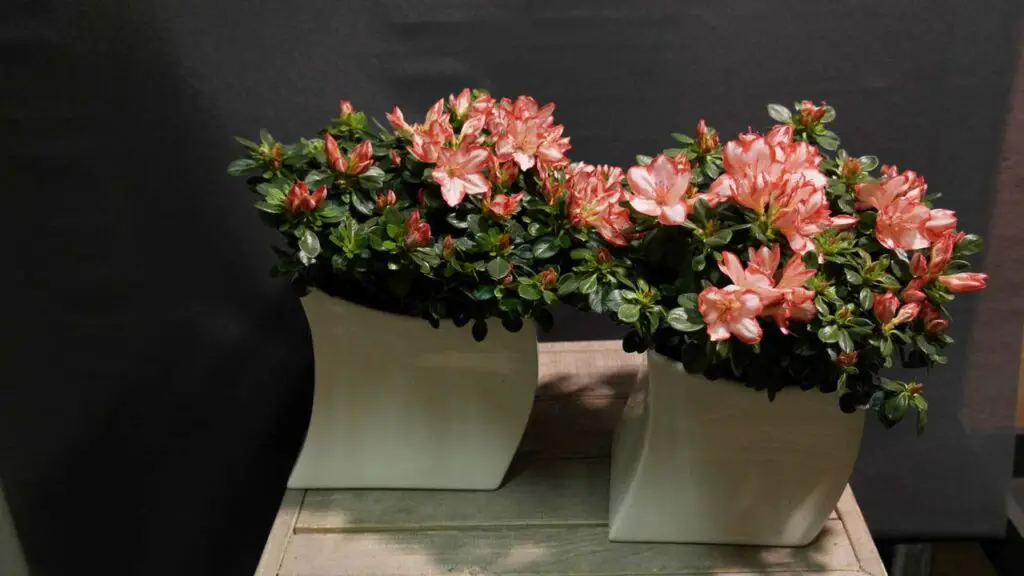
The plant is short. Strongly branched shoots. The leaves are evergreen, densely pubescent below. Flowering begins at 3-4 years of age. Inflorescences of various sizes and shapes (simple, double, semi-double). They can be of the most unexpected color – from purple to hot pink.
Advantages:
- Abundance, duration of flowering;
- Propagation by cuttings, dividing the bush;
- High decorative characteristics;
- Suitable for meditation;
- Bactericidal, aromatherapy;
- The positiveness of energy.
Disadvantages:
- Demanding for systematic watering;
- Special temperature regime.
To simplify adaptation to new living conditions indoors, you should buy one on which there are many unopened buds. Then it will bloom magnificently, effectively.
Spathiphyllum
An unpretentious representative of the Aroid family. The flower is suitable for single girls, women looking for a soul mate, happiness in love. Protects the house from negative relationships. Brings harmony and well-being to it.
Homeland – Venezuela and Thailand. Cleans the air from bacteria and harmful chemical compounds destroys mold spores. Helps relieve stress and tension. The juice is poisonous if consumed. This poses a danger to pets. At the time of flowering, it can cause allergic reactions.
Watering. In the warm season abundant, well-settled water. Needs systematic spraying. It is useful to periodically clean the leaves with a damp cloth. Topdressing is carried out from March to September.
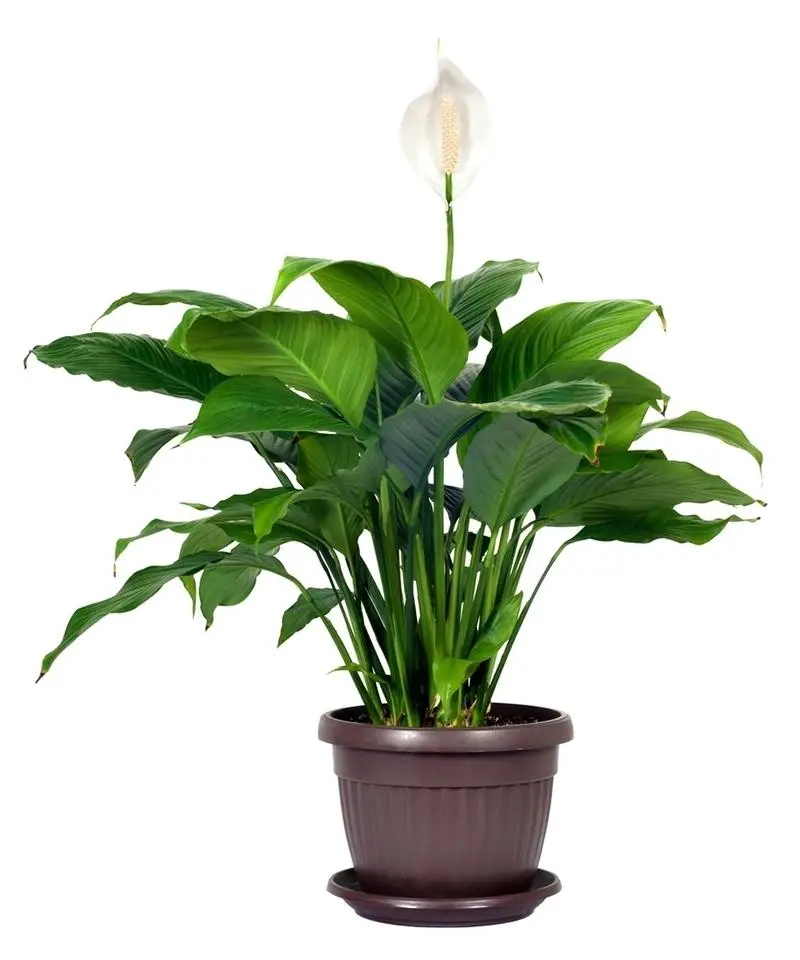
Leaf plates grow from the very root. The shape is ovoid. The color is deep green. Periodically produces a large peduncle, then a yellow-green ear appears, covered with a white blanket. There are more than 45 varieties in total.
Advantages:
- Unpretentiousness;
- Originality;
- Long bloom;
- Shade resistance;
- Propagation by cuttings, root division;
- Attracting female happiness.
Disadvantages:
- Toxicity;
- Requires frequent spraying.
At low temperatures and humidity, spathiphyllum will refuse to bloom. Shows vulnerability to drafts, direct sunlight. Suitable for growing beginners in floriculture.
Begonia
Representative of the Begoniev family. Planted in a pot or open ground. Blooms all year round, grows rapidly. Flower cells secrete phytoncides, which are detrimental to microorganisms. Volatile compounds neutralize staphylococcus aureus.
Homeland – Africa, America, Asia. Begonia has anti-allergic, wound-healing properties. It contains a lot of oxalic acid and tannins. Rich in organic acids. Useful for people with weakened energy.
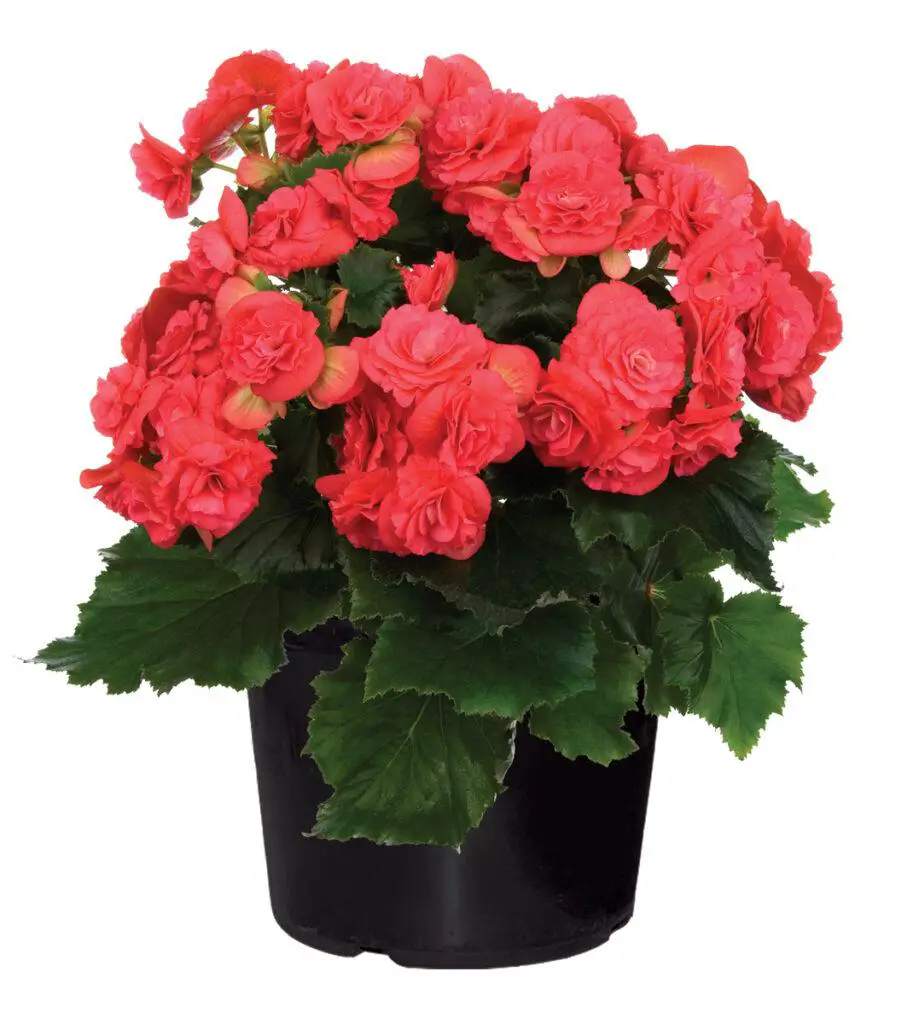
Watering: in the summer, once a week, in the winter, no more than 2-3 times a month, along the edge of the pot, without getting on the leaves and flowers. The water is warm and settled. It is important to avoid stagnant moisture. Begonia requires regular feeding, fertilization.
Want to know about Types Of Grow Lights For Indoor Plants.
It is a shrub with succulent stems. The sheet has an asymmetrical shape. Depending on the type (there are more than 400 of them), it can be round or elongated in length. Coloring from light green to bronze, from light pink to burgundy. Flowers are collected in loose inflorescences.
Advantages:
- Destruction of staphylococcus;
- Air ionization;
- Unpretentiousness;
- Rare watering;
- Home energy purification;
- Hypoallergenic.
Disadvantages:
- Leaf toxicity;
- Tinctures are prohibited during pregnancy and breastfeeding.
The transplant is done once every 2 years. It is necessary to humidify the air by placing bowls with wet moss or sand near the begonias. They grow well in warm rooms, poorly tolerate direct sunlight.
Oxalis
Nominee of the oxalis family, belongs to herbaceous perennial plants. Its foliage is famous for its sour taste, hence the name. It is also edible, useful to the human body ascorbic, oxalic acid.
It originates in Mexico and is also distributed throughout South Africa. Popular due to its unpretentiousness, endurance before diseases, aesthetics of the crown. It boasts a list of medicinal properties – bile, diuretic, anti-cold.
Watering: in summer several times a week with short periods of soil drying, in winter much less often. It should be fed during the period of active growth once every 3-4 weeks with any soluble fertilizer. The temperature regime that oxalis will like is 18-20 degrees.
The color of the leaves, depending on the variety (there are more than 800 of them), varies from emerald green to dark purple. It blooms while the weather is warm, generous with the sun’s rays, delighting with single small flowers inside the umbrella inflorescences.
Advantages:
- High growth rate;
- Long bloom;
- Medicinal properties, edibility;
- Perennial;
- Unpretentiousness;
- Decorativeness.
Disadvantages:
- Needs spraying in case of heat;
- Requires regular feeding.
Oxalis is often referred to as a butterfly because its leaf plates have a folding shape. They roll up like an umbrella if they suffer from mechanical damage, drafts and cold winds, as well as when night falls.
Camellia
A family of teahouses. It was named so in honor of the naturalist GI Camelius, who was the first to bring this vigorous plant from the Philippines to Europe. With careful care, it can reach up to 4 meters. Used as a raw material for a tea drink.
Found in tropical and subtropical regions of Asia. In the form of medicinal infusions, buds (buds) and leaves are used. Active substances help to fight obesity, promote the elimination of toxins. Camellia oil is processed for cosmetic purposes.
Watering: in warm weather, abundant, but the liquid should not stagnate in the soil. The water is soft or settled. Requires high humidity. Fertilizing is important all year round, once every 3 weeks.
Compact, evergreen shrub. The leaves are glossy, ovoid. Leathery to the touch. They grow separately or 2-3 pieces at a time. Flowers appear from November to May, they are large, pink, red, white, variegated.
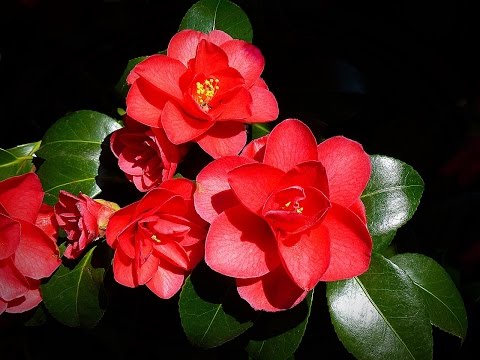
Advantages:
- Medicinal, cosmetological properties;
- Decorativeness;
- Seed propagation;
- Antitoxicity;
- Use as a tea drink;
- Flowering duration.
Disadvantages:
- Capriciousness;
- Frequent spraying.
Camellia requires favorable temperature conditions. In winter, cold is needed, in the apartment it will quickly die. Therefore, it is necessary to keep the flower on the glazed balcony at a temperature not higher than + 10 … + 15 ° C.
Orchid
Orchid family. Has a unique structure of a part of the root. Some shoots are located in the open air, they are not covered with substrate. Such indoor flowers are used as a decorative interior decoration.
Homeland is the southeast of Asia. Orchid attracts with its tenderness, charm. Used by the food industry as a spice. Medicine – as a tonic, pain reliever. Capable of releasing substances that kill pathogenic bacteria and microorganisms in the air.
Watering: 2-3 times a week in the summer, once in the winter. The soil should not be waterlogged. Pour water directly onto the root zone. The orchid is disease resistant. Top dressing is a vital necessity for her.
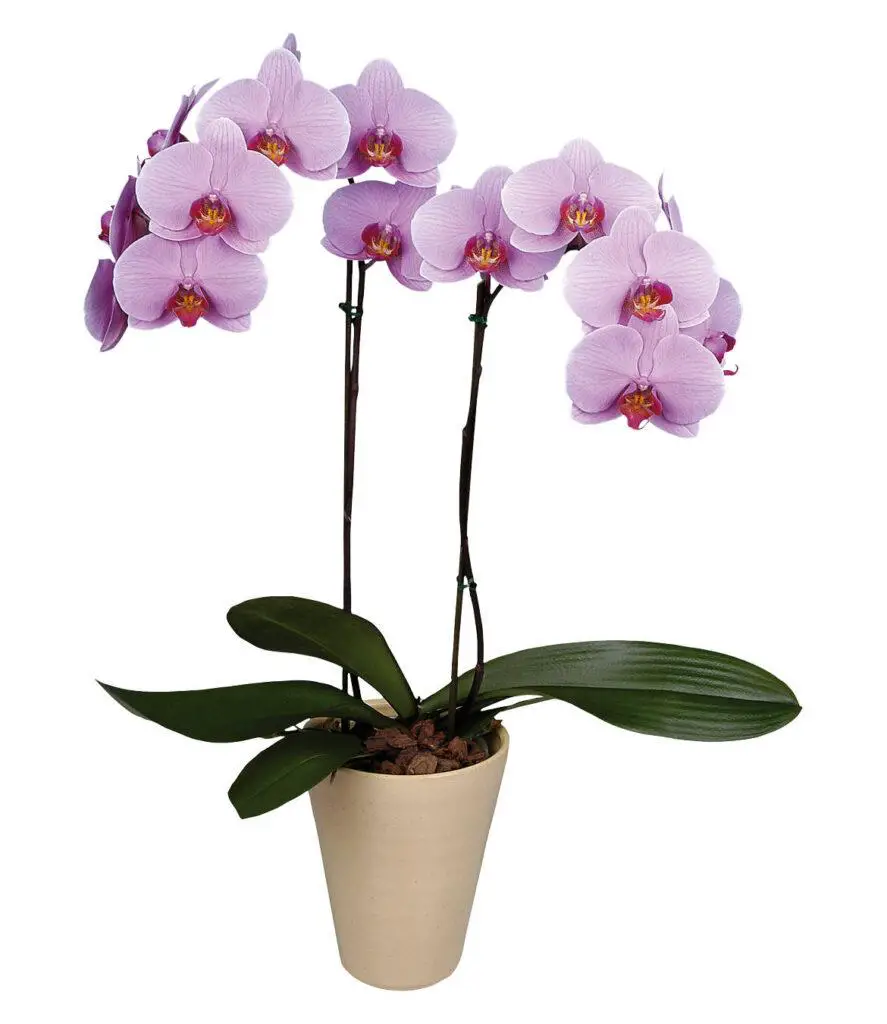
The appearance depends on the variety (over 25,000). The leaves are simple in shape. Their number is varied. The inflorescence is large in the form of an ear or a simple brush, of various colors with a delicate, delicate aroma.
Advantages:
- Long-term decorative flowering;
- Aroma;
- No need for an annual transplant;
- Rare watering;
- Use by medicine, food industry;
- Persistence of bouquets.
Disadvantages:
- Cost;
- Demanding growing conditions.
Planting is recommended inside a transparent pot. This allows you to monitor the development of the root system. Spraying with warm water is also important. During flowering, it is better not to rearrange the pots from their usual place.
Recommended for you Indoor Flowers That Bloom All Year.
how to choose indoor plants?
There are several defining criteria by which you can choose which flowers to keep at home. These are the growing conditions – exactingness to care, temperature, humidity, lighting. And then consider your personal preferences.
Ease of care
The most demanded today are mostly unpretentious indoor plants. Find out in advance about the requirements, needs (what kind of soil they prefer, in which pot they grow, how often they require watering, feeding, etc.), compare them with your capabilities.
Lighting
As practice shows, predominantly flowering indoor flowers, succulents, need bright lighting. Trees, large-leaved families prefer partial shade. This factor influences your choice, since it is already possible to determine in advance in what place, taking into account the lighting, this or that flower will be located.
Temperature
Most of the nominees and our top part come from the subtropics, tropics. The initial growing conditions determined the requirements for air temperature and indoor microclimate. It is important to consider that the colder the air, the higher the humidity.
Humidity
Another important factor on which the growth and health of home flowers depends is humidity. Its optimal level protects the crown from drying out or decay, the development of fungi and bacteria. Before buying a particular plant, compare its humidity requirements with the conditions of your house or apartment.
Personal preferences
If decorative properties are not so important to you, choose unpretentious flowering houseplants. In pursuit of a beautiful crown with an original design, year-round spectacular flowering, you will have to spend more time and effort to create an optimal microclimate. Before buying, see the photo of how this or that option looks.
What are the best indoor house plants?
After getting acquainted with the names of indoor plants, the criteria for the correct choice, the search circle for you should significantly narrow. There will be no unequivocal recommendation from Houseplantspro since everything is individual. But several nominees definitely deserve your attention:
- Aloe is an irreplaceable helper of antiseptic, anti-cold, anti-aging action;
- Monstera is a good decoration for large spacious rooms, oxygen purification, air humidification;
- Violet – delicate, lush bloom, the most compact nominee in our rating;
- Azalea – the most valuable nominee due to its bactericidal properties, meditation accompaniment + aromatherapy;
- Begonia – staphylococcus exterminator, the best offer for allergy sufferers;
- Orchid is the most popular, spectacular type of flowering, decoration of any interior.
Before you buy something, be sure to consult in order to prevent errors and care errors. Be sure to match his living conditions with your regimen. Consider the benefits and harms of each nominee when deciding which room to place him in so that his influence is only beneficial.
